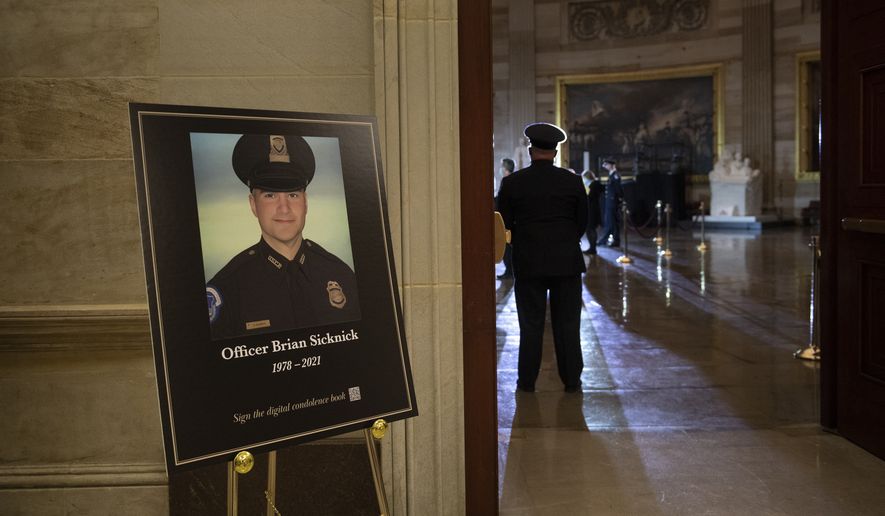Capitol Police Officer Brian Sicknick died of natural causes, one day after fighting off rioters during the Jan. 6 attacks, the District’s medical examiner said Monday — debunking rampant reporting and speculation in the news media that Trump supporters were responsible for the death.
Chief Medical Examiner Francisco Diaz said Sicknick suffered strokes and there was no evidence his death was a homicide, nor any indication that he suffered internal or external injuries.
The medical examiner’s report concluded that Sicknick, 42, died from “acute brainstem and cerebellar infarcts due to acute basilar artery thrombosis,” which is a medical term for a devastating stroke.
He collapsed from the stroke at 10 p.m. on Jan. 6 and died the next day at 9:30 p.m., according to the report.
The conclusion rewrites the narrative around Sicknick’s death, as numerous early reports claimed the officer had been beaten to death with a fire extinguisher. Later reports indicated he’d died as a result of inhaling an aerosol-based “bear spray” used by pro-Trump rioters.
In a separate interview with The Washington Post, Dr. Diaz confirmed that there was no evidence that Sicknick’s stroke was linked to the bear spray.
He said that if Sicknick suffered an allergic reaction to the chemical substance, his throat would have seized and there was no evidence of that.
House Minority Leader Kevin McCarthy, California Republican, blamed Democrats for the false reporting surrounding Sicknick’s death, saying they used it to score political points.
“His death was tragic, but what was even more tragic was how Democrats tried to politicize it,” Mr. McCarthy said in a Fox News interview. “[That] takes away everything he served for. That’s a real problem when they try to make so much politics out of this.”
Sicknick was one of five people who died at the riot. The rest were supporters of former President Donal Trump.
Those who died that day were Kevin Greeson, 55, of Alabama; Benjamin Phillips, 50, of Pennsylvania; and Rosanne Boyland, 34, of Georgia. Greeson and Phillips died of natural causes from cardiovascular disease, according to the medical examiner’s office.
Boyland died of an overdose of methamphetamine.
The only violent death at the riot was that of Ashli Babbitt, 35, who was fatally shot by a Capitol Police officer while trying to break through a window near the House Chamber.
Dr. Diaz last month declared her death a homicide, but the Justice Department said it will not file criminal charges against the officer.
The Justice Department said there was insufficient evidence to conclude the officer acted recklessly or that contradicted claims he feared for his life.
Federal prosecutors charged two men with assaulting Sicknick with a chemical, believed to be bear spray. The men have not been charged with his death.
Julian Khater, 32, of Pennsylvania, and George Pierre Tanios, 39, or West Virginia, each face nine criminal counts, including three counts of assaulting an officer with a deadly weapon, conspiracy to injure an officer and physical violence on restricted grounds.
The assault charges each carry a maximum of 20 years in prison and a $250,000 fine.
The cause of Sicknick’s death has been one of the biggest mysteries emerging from the Capitol riot when a pro-Trump mob stormed the building to stop Congress from certifying President Biden’s election victory.
Even after Dr. Diaz last month released the causes of death for four other people who died during the riot, he said the Sicknick investigation was “still pending.”
Federal and city officials kept silent about the probe. FBI Director Christoper A. Wray refused to answer questions from lawmakers on the Senate Judiciary Committee about the Sicknick investigation.
“We are not at a point where we can disclose or confirm the cause of death,” he said during testimony last month before the committee.
Misinformation surrounding Sicknick’s death fueled rampant speculation about what happened.
Hours before Sicknick’s death, Gus Papathanasiou, chairman of the Capitol Police Force Union, told a D.C. television station that the officer was already dead.
The Capitol Police immediately rushed out a statement insisting reports of Sicknick’s death were “not accurate.” Mr. Papathanasiou retracted his statement.
In a CNN interview that evening, Mr. Papathanasiou said there had been “misinformation” about Sicknick’s condition. CNN had also prematurely reported his death, citing three sources.
Mr. Papathanasiou later said Sicknick suffered a stroke, which was the same explanation provided by Sicknick’s family.
CNN wasn’t alone in misreporting on the case.
The New York Times in January reported that protesters bludgeoned Sicknick to death with a fire extinguisher. A story later that day said being hit with a fire extinguisher caused a “bloody gash” on Sicknick’s head.
A few weeks later, The Times backtracked from the fire extinguisher story and quietly issued a clarification to previous stories about Sicknick’s death. The clarification states that “new information” raised questions about the cause of death initially offered by sources close to the investigation.
Sicknick’s brother told ProPublica that he got a text from Sicknick after the riot saying he got pepper-sprayed twice but was in good shape.
The next day, the family was told that Sicknick had suffered a blood clot and a stroke, according to the brother.
• Jeff Mordock can be reached at jmordock@washingtontimes.com.




Please read our comment policy before commenting.